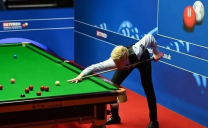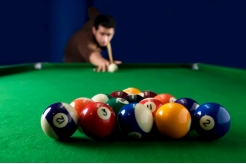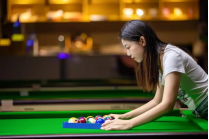When you are eager to achieve breakthroughs in your billiards skills, mastering scientific and effective practice methods is the key. The following practice methods, from strengthening basic skills to dealing with complex scenarios, will comprehensively help you improve your billiards level.

I. Special Practice of Advanced Cueing Techniques
Practice of Composite Cueing Techniques
Composite cueing techniques integrate multiple basic cueing techniques and can deal with complex billiard situations. Start with the combination of top spin and side spin. Place the cue ball and the object ball on the billiard table, and set a target that the object ball needs to enter the pocket through a specific route, and the cue ball’s position should reach a designated location. When hitting the ball, accurately aim at the upper part of the center of the cue ball and the side where side spin needs to be applied. For example, for top spin with right side spin, first feel the forward pushing force given to the cue ball when hitting with top spin, and at the same time, skillfully apply a rightward rotational force. Repeat the practice several times, carefully observe the movement trajectory of the cue ball after hitting the object ball, compare the expected and actual effects, and continuously adjust the hitting point and the way of exerting force. After mastering top spin with side spin proficiently, try other combinations of composite cueing techniques such as bottom spin with side spin, and gradually improve your ability to use composite cueing techniques.
Practice of Curve Ball and Jump Ball
1. Curve Ball Practice: Set up obstacle balls on the billiard table to simulate the scenario where a curve ball is needed to bypass the obstacles in actual combat. Start with simple obstacles, such as a single obstacle ball located in the middle of the straight line between the cue ball and the object ball. When hitting the ball, accurately control the hitting point and the strength of side spin according to the position of the obstacle ball and the expected curve of the cue ball. For example, to make the cue ball curve to the right to bypass the obstacle, the hitting point should be on the right side of the center of the cue ball, and when exerting force, make the cue stick have a rightward tangential force. As the practice progresses, increase the number and difficulty of the obstacle balls, such as setting multiple obstacle balls to form a complex route, and continuously improve the curve ball technique.
2. Jump Ball Practice: Prepare several balls and place them at intervals on the billiard table to simulate the obstacle ball formation in actual combat. Start practicing with jump balls of a lower height. Quickly and forcefully hit the lower middle part of the cue ball with the cue stick, and at the same time, quickly flick the wrist upward to give the cue ball an upward force to make it jump. Pay attention to observing the jumping height and landing position of the cue ball, and adjust the hitting force and the timing of flicking the wrist. After being able to stably complete low-height jump balls, gradually increase the height and difficulty of the jump balls, such as making the cue ball continuously jump over multiple balls, and improve the accuracy and stability of the jump ball.

II. Simulation Training of Complex Ball Shapes
Practice of Multi-ball Related Ball Shapes
Randomly place multiple balls on the billiard table to simulate complex ball shapes with multi-ball relationships. First, analyze the positional relationship between the balls and determine the key ball, that is, the ball that can open up the situation and create subsequent hitting opportunities after being pocketed. For example, in the scenario of Chinese-style billiards, when facing a ball shape with a mixture of colored balls and solid balls, if there is a ball that can make the distribution of other balls more conducive to continuous hitting after being pocketed, it is the key ball. Calculate the hitting angle and force, consider the movement trajectory of the object ball and the position of the cue ball after the cue ball hits the key ball, and ensure that while pocketing the key ball, the cue ball can be in a position convenient for the next shot. Summarize the experience after each practice, think about how to better handle similar ball shapes, and improve the ability to deal with complex ball shapes.
Practice of Obstacle Ball Scenarios
1. Curve Ball Over Obstacle Practice: Closely arrange multiple obstacle balls, place the object ball on the other side of the obstacle balls, and the cue ball on this side of the obstacle balls. Try to use the curve ball technique, and by precisely controlling the side spin and force of the cue ball, make the cue ball bypass the obstacles along a curve and hit the object ball. Continuously adjust the hitting parameters, such as the hitting point, the direction and strength of the force, to adapt to different obstacle ball layouts, and enhance the ability to use curve balls in complex obstacle scenarios.
2. Practice of Combining Jump Ball and Rebound Ball: Set up multiple layers of obstacle balls. First, use the jump ball to cross some of the obstacles, and then use the rebound of the cue ball after hitting the cushion to change the direction and hit the object ball. During the practice process, accurately calculate the height and distance of the jump ball and the position of the rebound point, repeatedly try different combinations of hitting force and angle, and improve the proficiency of combining the use of jump balls and rebound balls to deal with complex obstacle ball situations in actual combat.

III. Practical Strategy Drills
Practice of Attack-Defense Conversion
Conduct simulated match practice with your billiards friends and deliberately train the ability of attack-defense conversion in the match. When the ball shape is favorable, decisively attack and strive for consecutive scores, but plan the position of the cue ball before each shot to ensure a good attacking opportunity for the next shot. If the ball shape is complex and the position of the cue ball is not good, promptly switch to defense. By precisely controlling the cue ball, place it in a safe area and at the same time create trouble for the opponent, such as making a snooker in a snooker game. During the defense process, always observe the opponent’s hitting habits and weaknesses. Once the opponent makes a mistake, quickly seize the opportunity to switch to attack. Through multiple simulated matches, master the timing and techniques of attack-defense conversion proficiently.
Practice of Psychological Pressure Resistance
1. Timed Hitting Practice: Set a time limit for hitting the ball, such as a 30-second limit for each shot. Conduct hitting practice under time pressure to simulate the tense rhythm in the match, exercise the ability to think quickly and hit the ball accurately within a limited time, gradually adapt to the time pressure in the match, and improve psychological quality.
2. Simulated Key Ball Practice: Set up key match scenarios, such as in Chinese-style billiards, simulate the scenario where you are one ball behind in the deciding game and need to pocket two key balls in a row to win. Conduct hitting practice in this high-pressure situation. Through repeated practice, enhance the psychological quality when dealing with key balls, overcome nervousness, and stably demonstrate your technical level.
Through these targeted practice methods, continuous training and continuous summarization of experience, you will achieve significant improvement in your billiards skills and show stronger strength on the billiard table. Spike Billiard Table is directly sold by the source manufacturer, opening a new channel for a high-quality life. With innovative thinking and practical actions, we provide you with better products and services. If you have any questions or experiences during the practice process, you are welcome to communicate at any time, and we can jointly explore the path of billiards advancement. https://www.tiktok.com/@spk.billiard?_t=8qRRRnXP4N8&_r=1
